Is this how Scotland's nationalised railway is meant to look?
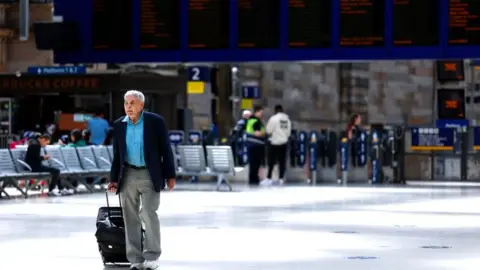 Getty Images
Getty Images- Another stoppage on the railways highlights the battle over pay, waged most ferociously by those with the most leverage, but also with most to lose as efficiency and changing travel patterns threaten employment conditions.
- Renewed public control of railways brings high expectations of what can be achieved, but limited prospects of them being met - not least because so much money will be required to replace diesel trains, and on some tricky lines north of the Central Belt.
- Those are among the targets for reducing carbon emissions in Scotland, which are reckoned by one think tank to be lacking the big and difficult decisions required.
Your ScotRail train may or may not depart on time. It depends if the crew were to be on overtime or not. This is ScotRail's second 24-hour strike by RMT transport union members, to add to all those one-day stoppages in protest at other rail companies.
Is this how a newly nationalised rail service is meant to look?
The first RMT strike over ScotRail's pay offer was earlier this month, on the day the SNP conference departed Aberdeen.
Members moved from a vision of a greener, smooth-running Scotland in the P&J Arena to the city centre, and a clunking re-engagement with a very different reality on the rails.
When they do run, trains south of Aberdeen are all diesel. There's a lot of work to do, and a lot of money to find, if ScotRail is to meet expectations of the public ownership that began just over six months ago, and if it's to banish diesel from the fleet, as intended, within only 13 years.
There's pressure on Jenny Gilruth, Scotland's transport minister, to deliver cheaper fares, more carriages, and free tickets for young people, just as they can get free travel on buses up to the age of 22.
She's being told to re-open rail lines, as they've done in the Borders, Alloa, and they'll soon do in south-east Fife.
If Aberdeen is to become, as the First Minister ambitiously claimed, "the net zero capital of the world", it is going to need some greener rail options. It won't get electric trains linking to Dundee until 2030, and there's a case being made for reinstatement of a rail link with Peterhead.
It would be nice, on a strike day or any other, to have the alternative option of a direct Citylink coach service between Aberdeen and Inverness. But no such service exists. Incredibly, you have to change at the Broxden interchange near Perth.
I used it recently, with foreign tourists who were left with little shelter and less information, while unable even to get into Perth city centre. The Broxden car park has become a pivot point for Scottish road travel, but is surely one of the nation's most dismal places.
An almighty squeeze
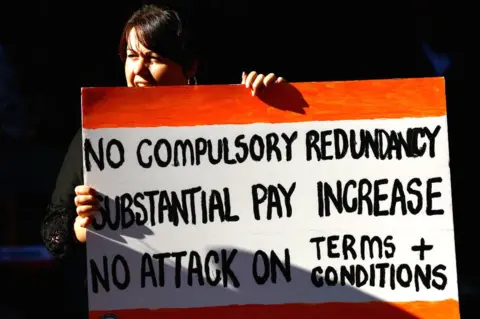 Getty Images
Getty ImagesJust one of the big problems for Scotland's rail, as with much of the rest of Britain, is that it's coming back into public ownership, or at least control, at a time when there's an almighty squeeze looming for public funding.
Experience tells us that long-term infrastructure, such as rail, is the first and easiest area of public spending to squeeze.
The other notable, current problem is that the pandemic has upended the market for passenger travel. And while most other markets are re-conforming to roughly their previous shape, rail seems to have changed permanently.
Strikes this year are not only because earnings are failing to keep pace with price inflation, but because staff have good reason to think that big changes are on the way, and they won't be comfortable for staff.
ScotRail has the lowest level of passenger recovery of any of the major British franchises. In April to June, it had only 61% of the numbers it was carrying before the pandemic.
It is making only 75% of the revenue from that time - an improvement, at least, on the 9% of revenue in the depths of lockdown, when vast public subsidy was required to keep any trains running.
Travel for leisure has picked up significantly since coming out of Covid restrictions. But commuting has not. Use of season tickets across the network during spring were at only 34% of pre-pandemic levels.
Many people have not returned to office work. Those who do are often doing so for fewer days per week, enjoying the flexibility to leave home later in the morning and avoid peak time fares. ScotRail says that a high proportion of its customers have moved homes or jobs since 2020.
Reliability, safety and clean toilets
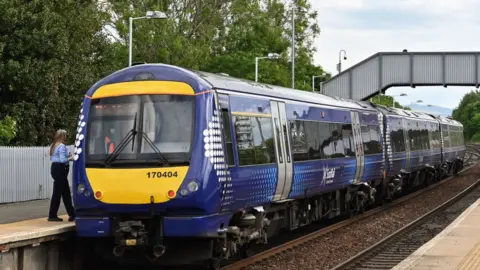 Getty Images
Getty ImagesThe notion of peak time is hard baked into railway ticketing, while air and bus travel has adapted to pricing models in which ticket prices adapt to demand.
We've been told there will be an end to the absurdities of return tickets being less expensive than single journeys, and saving money by buying a ticket for a station beyond your destination because that is cheaper.
We've awaited a Scottish version of London's Oyster Card for so long that the Oyster Card has itself been replaced by smarter ways to get the best deal simply using a payment card.
You'll know what I mean if you use Lothian Buses, but you won't find much that joins up. A seemingly simple journey requires not only different tickets but different apps.
Surveys suggest that passengers have a fairly high satisfaction rating with Scottish trains. They are looking for reliability, safety, clean toilets and for some of them (mainly men) speed.
That makes it more difficult to explain why the vast bulk of railway spending for now, and quite a few years to come, will be on improving resilience against extreme weather and taking carbon off the tracks.
It's something that passengers are only likely to notice when they breathe the cleaner air in Glasgow Queen Street station, but they will pay much of the price.
The hydrogen take off
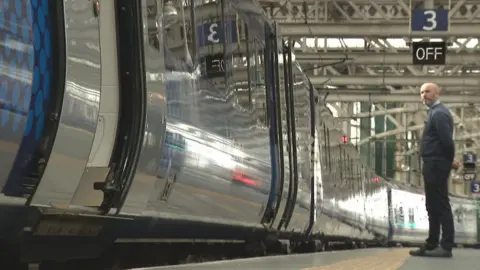
Alex Hynes, managing director of ScotRail, was in Inverness recently, and took time with journalists to explain some big challenges ahead.
They include the replacement of diesel on lines running north of Perth and Dundee. Options are currently being considered for how to put an overhead cable on tracks between Inverness and Perth. It might be possible as far north as Tain in Easter Ross.
But on the Kyle of Lochalsh line, between Inverness and Aberdeen, and from Tain north to Caithness, different options will have to be considered.
Hydrogen is one. Germany is already running hydrogen-powered trains. They have been trialled in Britain. We have moved sharply this year, thanks in large part to Vladimir Putin, from hydrogen being a distant wish on the horizon to an industry that's about to take off.
It's not clean and green, however, if it's 'blue hydrogen' and being sourced from gas. 'Green hydrogen' requires renewable power to derive it from water, and that is pricey.
Wider gauge trains on the continent, along with bigger bridge and tunnel spaces, allow for designers to put hydrogen in the roof space above passengers heads. British trains may have to tow hydrogen tanks in an extra carriage.
The Highland lines in particular have some exceptionally tight bridges and tunnels. Replacing Victorian bridges to create space for electric cables is extraordinarily expensive and disruptive - as anyone in Glasgow can see from the year-long replacement of just one bridge where Pollokshields meets Strathbungo.
Cost of electrification
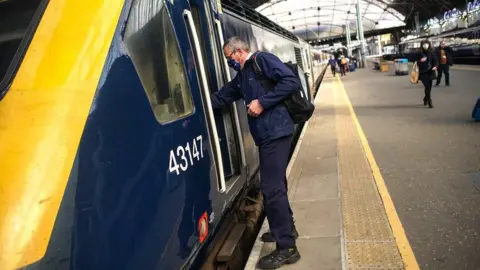 Getty Images
Getty ImagesThe difficulty for planning ahead is that the technology and the relative prices keep changing. Electrification is today's technology, and works best in urban areas.
Hydrogen is very expensive now, but the price of sourcing it and running trains on it could fall sharply. Battery power has already seen that happen, as the distance range of trains - as with battery cars - has risen sharply. But they are not yet able to plan on batteries getting trains as far north as Wick and Thurso.
Alex Hynes claims that Scottish railways are doing better than England at reducing the cost of electrification, at £2m per track kilometre compared with England's £3m.
That's a big improvement on the late and over-budget electrification of the main Glasgow-Edinburgh line through Linlithgow.
The ScotRail boss has recently been finding out how Denmark's railways have got that cost down to £1.5m.
Among his next tasks is to start ordering new fleets: Next year battery-electric, the year after for rural lines, and the year after that, replacement of the intercity fleet. They're looking at replacing not just the trains, but at ownership in place of leasing trains.
The reality gap
It's a colossal task to achieve these net zero targets, and that's just rail. The easy option is for the First Minister to attend the COP27 climate change gathering in Egypt, to follow up on the profile she gained last November in Glasgow.
But a recent report from the Reform Scotland think tank points out that big, difficult decisions are not being made, which risk unpopularity, but it argues they will become essential - no more new buildings heated with gas, no new gas cooking hobs, and pay-as-you-drive road pricing.
The report identified 45 Scottish government targets for achieving that net zero vision, while noting the lack of monitoring or accountability for failing to hit them.
It sees a gap between rhetoric and reality in what will be required for changes to individual lifestyles and freedoms.
The think tank's Alison Payne observes: "Without transparent and accountable tracking of these goals, there is a danger they become worthless.
"There is a long way to go, but we can reach the end of the journey by taking bolder steps now."
